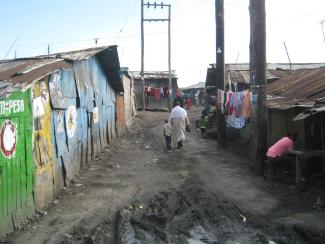Affordable housing
Why the government’s housing policy is failing in Nairobi

After Kenya shut down its economy to battle the coronavirus pandemic, its comedians took to social media to entertain the public with stories of their journeys to stardom. Their tales tended to follow a rags-to-riches narrative: They left rural homes and moved to a big city to try their hand at an acting career. They shared single-roomed, tin-walled shacks with other impoverished residents in Nairobi’s slums. Some slept on the streets. Others were housed by relatives or sheltered by prostitutes, living in dingy dwellings in back alleys. But eventually they achieved fame and fortune.
As entertaining as these stories are, they expressed the reality of most migrants to Kenya’s teeming cities. Many young people still stream into cities from the countryside, hoping for opportunities and a decent income. But it is a hard struggle, particularly for the 99 % of the workforce who lack higher education.
For those with a secondary school certificate or lower, a move to the city usually leads to work in the informal sector, where over 80 % of Kenya’s workforce toil. They do any kind of work to buy food, pay rent, and perhaps send some money to their families in the village. They work as apprentice mechanics, welders, carpenters or household helpers. Or they hawk fruits, second-hand clothes, umbrellas and pencils. They live in dire circumstances but have no proof of a monthly income that would enable them to take on a mortgage and improve their living conditions. They have no social protection such as health insurance or an old-age pension scheme.
Nonetheless they keep coming. The share of Kenyans living in cities and surrounding urban areas quadrupled from eight percent in 1963 to 32 % in 2019. The 2019 census shows that 39 % of Kenyan households, comprising about 15 million people, are in urban areas.
People keep coming mainly because urban jobs pay more. By law, the minimum wage for menial jobs in Kenya’s three cities – Nairobi, Mombasa and Kisumu – is almost double that of rural areas. Gardeners, street cleaners, watchmen and housekeepers in cities are entitled by law to 13,572 Kenyan shilling (KES) (135 US$) a month, compared to 7,240 KES (72 US$) in rural areas.
Since independence in 1963, Kenya’s policymakers have known that the steady migration to cities is a ticking time bomb. The stream of unemployed people into cities worsens existing joblessness and adds to the already severe urban housing shortage.
Upon his reelection to a second term in 2017, President Uhuru Kenyatta announced a plan: He promised that the government would build 500,000 affordable housing units in urban areas within five years. His government created a mortgage finance corporation to lend money to financial institutions for onward lending to Kenyans buying these and other homes.
But the project is floundering. The courts struck down a presidential proposal to levy a tax to finance the housing fund. The proposed tax was hugely unpopular among formally employed middle-class Kenyans. They felt that they were being forced to buy houses they did not need, or to pay for houses for other people.
Build it yourself
Indeed, most Kenyans shy away from mortgages. Kenya has only about 27,000 mortgages, according to the Central Bank. While 61 % of Kenyans own their homes, only three percent of those homeowners actually bought the houses, while 93 % of homeowners built their own houses and three percent inherited them, according to the Kenya National Bureau of Statistics.
The vast majority of the owned homes are in the countryside. While the government focuses on alleviating conditions in urban slums by encouraging people to buy government-built city homes, the Kenyans who are most inclined to own their homes already do so – in the countryside. In the cities, people overwhelmingly tend to rent. A mere nine percent of Nairobians live in a home they own. The city counts 1,5 million households, of whom 91 % are renters.
One reason for Kenya’s urban-rural dichotomy in home ownership is cultural. Kenyans tend to consider cities places to work and earn money, but do not call them home. Their homes are in their rural ancestral lands, to which they return at Christmas, Easter and other holidays. Retirees tend to return to their villages as well.
Another reason that city residents tend to rent their housing is that urban housing is very expensive. Household incomes are typically too small to afford real-estate investments. Three-fourths of employed Kenyans earn less than 50,000 KES (500 US$) a month. Moreover, administrative hurdles and bureaucratic bottlenecks in property registration and titling make home acquisition difficult. Corrupt officials have a pattern of creating bottlenecks to extort money, moreover. On top of all this, interest rates on mortgages can be as high as 14 %.
Despite the preference of city residents to rent rather than buy, the government decided to build hundreds of houses and offer them for sale or rent at subsidised rates to slum dwellers. The idea was that poor people would want to improve their living conditions, so the government should enable renters to start a journey towards home ownership. It is not working out. Some slum dwellers accepted the subsidised home-purchase terms, but they did not move into the new housing. Instead they sold their subsidised units to others and went back to live in the slums. Others accepted subsidised rent-to-purchase terms but then sublet their units, pocketing the rent while continuing to live in their slum home.
Home truths
One important lesson from this sad experience is that at base of the housing problem is an income and employment crisis. To solve the shortage of decent urban housing, the government must first improve the job-creating capacity of the country’s economy – in both urban and rural areas. That would raise incomes to the point where urban slum-dwellers could move into better housing on their own. It might also dampen the tendency to move from the countryside to cities in search of work.
Another lesson is that the government has no business trying to build and sell homes in cities where most people shy away from home ownership. At best, the government should remove barriers to home ownership, such as bureaucracy and corruption in the titling process, high interest rates, and heavy taxes on building materials such as cement and steel.
The government could also improve conditions in the slums by providing better urban infrastructure in areas such as roads, sanitation, internet connectivity, electricity, water and waste-management.
Beyond that, however, the government should get out of the way and enable Kenyans to do what they are inclined to do anyway – at least in the countryside – which is to build their own homes. That is what nine out of ten Kenyan homeowners already do. Policy should follow a pattern that already works for most citizens.
In short, the government should leave building and selling houses to the private sector. It should not try to impose a new approach that distorts the housing market and allows some of the intended beneficiaries of its well-intentioned policies to game the system.
Alphonce Shiundu is a Kenyan journalist, editor and fact-checker based in Nairobi.
shiunduonline@gmail.com
Twitter: @Shiundu














